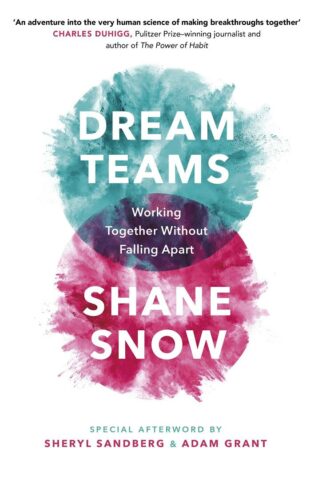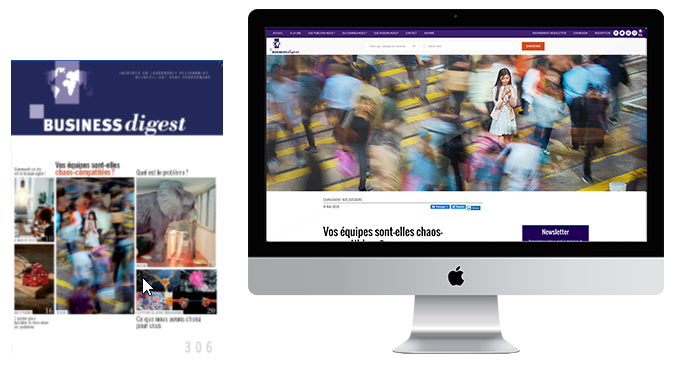Diversity, fluidity, agility: why is it getting stuck?
For your staff to adapt smoothly to a troubled and fast moving context, they have to be kitted out with the best possible cognitive toolbox — one that will help them devise new solutions in real time. But what are the tools and why is it such a struggle to exploit them?
Optimizing teamwork is more important today than it has ever been. You may think that going solo will allow you to reach your goal more quickly, but, in fact, pooling diverse talents allows you to generate disruptive solutions that are tailored to our turbulent times. Author Shane Snow argues that the most enterprising companies routinely promote healthy confrontation between opposing points of view because collective intelligence can’t be conjured out of thin air: it needs to be worked on. If you don’t handle your team properly, its diversity can quickly become a disruptive force that shatters collective work. A subtle balance is necessary to take advantage of the differences between your employees and attain optimal collaboration. Within a dream team, divergent views create a wealth of ideas that combine to produce exceptional levels of performance.

Dream Teams: Working Together Without Falling Apart
by Shane Snow (Portfolio/Penguin, 2018).
The value of cognitive diversity in your team
If you can’t solve current problems using an operating method that’s worked in the past, the only solution is to think differently – and therefore to increase the cognitive diversity of your teams. Your teams should be made up of a patchwork of different profiles, points of view, and skills. These should be rich and varied enough to fashion tailor-made answers based on the synergy between the contrasting approaches employed.
- Diverse teams are the keystones to performance. Homogenous teams are effective at following procedures and performing repetitive work. But in the age of artificial intelligence, these teams are outperformed by machines, which do the same job but faster. For assignments requiring creativity and imagination — human input, in other words — even a group of star performers, all cast from the same mold (similar university courses and career paths), is outclassed by a group of less remarkable individuals with varied profiles. A diverse team with a rich cognitive toolbox is a unique and irreplaceable source of innovation and adaptability.
- When different points of view go head to head, it challenges the status quo — and helps unearth hidden gems. To avoid stasis, you need to foster divergent thinking and cultivate agents provocateurs who oppose the consensus. When somebody voices a minority opinion in a team (even if it’s a highly unlikely view), it stimulates curiosity. It’s a way of exiting your comfort zone of ready-made solutions that may be becoming obsolete. For instance, instead of polling average consumers, why not try focus groups of your most “extreme” users? These users would be much more likely to generate disruptive ideas that could inspire your future lead products.
What kills any attempt at diversity?
Cognitive diversity implies … diversity. Most corporate diversity programs don’t seem to be increasing diversity, and yet today there is an urgency to make progress on this issue. Even more than potential punitive damages, however, the most important reason to promote diversity are the numerous proven benefits of diverse teams.
#1 Are you just a “believer” or a true “builder”?
Author Dolly Chugh1 notes that many people say they wish to promote diversity and think of themselves as good people (being a “believer” in her parlance), and yet everyone still sometimes behave in ways that do not meet these standards. When challenged in our self-image (as a “good” person, for example), we tend to feel threatened and thus adopt a defensive posture that hinders us even further from being “the person we mean to be.”
Chugh suggests that we recognize that such binary ways of viewing the world (good vs. bad) is faulty. We are all operating on a continuum and, instead of judging ourselves and others, which tends to make us feel defensive, we should try to adopt a learning mindset when confronted with situations that make us uncomfortable. This is what it takes to become what Chugh calls a “builder.”
#1 Test your culture: auditing unconscious biases with your teams
Although we seldom deliberately hold unfair prejudices towards other people, we all convey preconceived ideas, often unconsciously. How do we set about challenging something that is invisible – our own prejudices and those of others – so we can promote diversity and make our teams more welcoming and efficient?
“A good place to start for examining your own prejudices is to take an online test and analyze your contacts and social interactions. You can also ask yourself a few simple questions. If, for instance, you design products, who tests them? What conferences do you go to? Or let’s say you are a therapist or doctor: how do you understand your patients’ grievances based on their gender and origins?”
The hurdles to overcome to make things work
Simply declaring that you’re going to diversify a team’s skills will not guarantee a fruitful outcome.
- Introducing diversity requires dexterity. A 2016 Harvard study on 700 US companies2 demonstrated that diversity programs, rather than giving better expression to “minority” groups and ideas, actually marginalized them even more. How can we explain this paradox? Scientific research shows that human beings find it difficult to manage difference. When faced with people who are seen as being dissimilar, our reptilian brains automatically generate stress. This means that employees have to be acclimatized progressively to diversity and helped to integrate “different” profiles rather than being forced to cooperate.
- A coalition of complementary talents might be ideal on paper, but it can prove lethal in practice. According to the Harvard Business Review, between 70 and 90% of mergers do not create synergy. Worse still, half of all deals actually destroy value. The historical failure of the Daimler-Chrysler merger is a good example. It seemed a promising match, a marriage between the high profit margins of the US manufacturer and the R&D expertise of the German firm. But the two juggernauts were suspicious of each other, and their respective cultures were too far apart. Staff ignored each other instead of collaborating, leading to an unprecedented drop in value.
How to be an effective team leader of diverse talents
Be prepared to navigate between two major hazards in your attempts to successfully lead a team of diverse talents:
- The danger of permanent conflict — working together turns into trench warfare and bickering;
- The temptation to flee and retreat — differences remain unspoken but the group gets bogged down in organizational silence, causing the downfall of the business (as was the case with Daimler-Chrysler).
Diversity is only positive if the tensions it generates are openly expressed and channeled properly.
Reaching the optimal collaboration zone
A team’s optimal creative zone is located halfway between its comfort zone, which breeds lethargy and inaction (when colleagues know each other by heart), and its “tension zone” (when individual initiatives compete with each other). Four steps will help you succeed:
- Work on creating bonds via daily social interaction to diffuse tensions between members of your team. By gradually getting colleagues used to each other — notably through play — you’ll create a sense of familiarity and dismantle the barriers in the reptilian brain. This will make it easier for people to speak freely and integrate all points of view.
- Muster your troops around a common cause that transcends differences. For example, help your team grow or win market share. The logic is simple: one for all and all for one.
- Respect individual personalities (and their idiosyncrasies) while uniting them around inclusive values so that friendly relations last. Snow argues that organizations that take this point seriously mobilize their troops the most quickly, boast the lowest turnover, and have the most sustainable activities. The logic, once more, is simple: united in diversity.
- Tell a story: the most potent tool to promote the feeling of group belonging is good storytelling based on emotions. This addresses the reptilian brain directly and is more effective than rational, fact-based discourse. BlackRock uses the power of storytelling on a more personal level by encouraging employees to share stories as a way of building mutual trust.
Building a first-rate team means being in a state of permanent adjustment to maintain a balance between the entropy inherent in a group of eclectic profiles and the need to channel their talents towards a common goal. Making a success of this sensitive exercise will create an exceptionally fluid form of collaboration, which is the mark of every close-knit, high-performance dream team.
© Copyright Business Digest - All rights reserved




